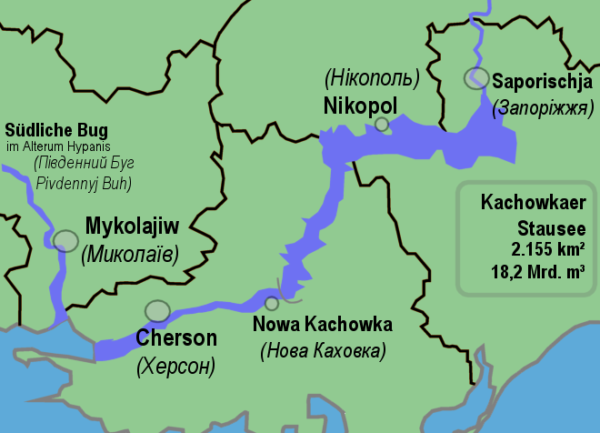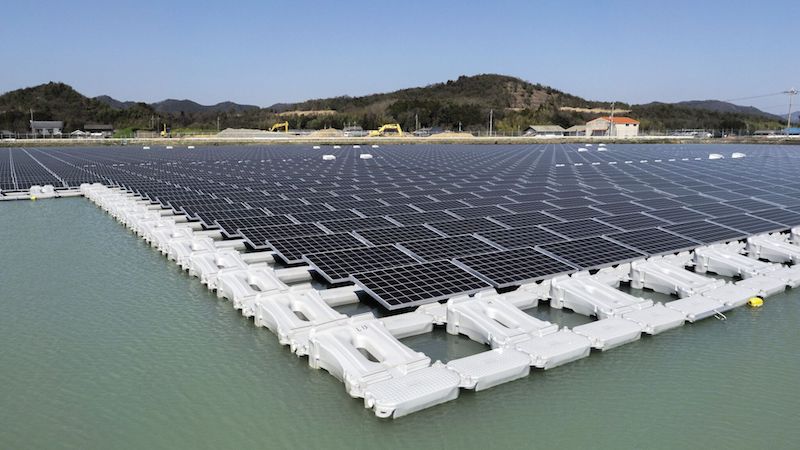Big and small-sized floating PV projects have been announced across several mature solar markets over the past two years, including in most European and Asian regions, like India, China, South Korea and Taiwan; and other Latin American countries, such as Colombia and Brazil. However, less mature markets, like Ukraine, are also starting to recognize their benefits.
The technology is particularly attractive for countries where land is limited, or where the costs of buying or leasing land are high. Energy infrastructure projects connected to hydropower, and businesses operating close to, or nearby, water, like fisheries, can also benefit from floating solar.
Up to 300 MW at a Ukranian water reservoir
Ukraine’s Ministry of Energy and Coal Industry announced last week that U.K.-based asset manager, Touchstone Capital Group Holdings Ltd is planning to build a GW-sized hybrid wind-solar power project at the Kakhovka water reservoir, located on the Dnieper River, alongside the Kakhovka Hydroelectric Power Plant.

Image: wikimedia commons, Francis McLloyd
In a conversation with pv magazine, Atanas Pashaliev, president Global Infrastructure of TFGH, said the project is expected to have a total capacity of around 1.3 GW, comprising 1 GW of wind capacity, and up to 300 MW of PV, provided by floating installations located between the wind turbines.
By using the areas between the turbines, the developers can install 2.8 times more capacity than wind alone allows, according to TFGH. Every section of the plant will consist of four wind turbines ranging in size from 4 MW and 5 MW, and an 18 MW PV plant, which will have its corners anchored to the foundation of wind turbines.
The project, which could also include storage units and the production of hydrogen, is expected to be implemented in the period between 2019-2024, and should compete in Ukraine’s future mixed wind-solar auctions, said Pashaliev. The huge power plant is expected to be connected to the grid of Ukrainian power provider, Ukrenergo NPC State Enterprise.
“The additional advantage of this kind of hybrid project is the availability of own balancing capacities, which will allow for a more even schedule of electricity generation,” the Ukrainian government said in a statement released on the project. Furthremore, both the Ministry of Energy and the project’s developer have clarified that the entire plant will rely on at least a 30% quota of locally manufactured components.
TFGH, which has its network in network in Beijing, Shanghai, Hong Kong, Singapore, Sydney, London and New York, operates in key sectors, such as utilities, transport, construction and social, via several entities. The holding company is primarily acting as and investment platform between China, where most of its businesses are located, and the rest of the world.
Floating PV in Afghanistan, Azerbaijan and the Kyrgyz Republic
In a separate development, the Asian Development Bank (ADB) has recently published a document, which shows the potential of floating PV technology in three countries with almost zero solar energy development – Afghanistan, Azerbaijan, and the Kyrgyz Republic – and which are all heavily reliant on either fossil fuels, hydropower, or imported fuels and power.
The ADB is now providing these three countries with support technical assistance (TA) to help them conduct tests and build expertise in the area of floating PV, and diversify their respective energy mixes, while at the same time increasing energy security and reducing CO2 emissions, according to the document.
It will also help them enhance their knowledge and technical skills in designing floating PV plants through pilot projects, commercial-scale project feasibility studies, and hands-on institutional capacity building, including in-depth study tours in leading floating PV markets.
In each of these three countries, land availability is a critical issue, as they are laced with hilly terrains, while the small parcels of available flat land are mostly used for housing or agriculture. “However, the countries have large lakes and reservoirs with perennially sunlit surfaces,” said the ABD.
Additionally, due to the existing hydropower energy infrastructures that have been developed in the Kyrgyz Republic, for example, and which represent 81% of total installed capacity, costs of floating PV projects are further reduced, as the power density in megawatts (MW) per flooded area is significantly increased, with the floating solar array enabling time-shifting of hydropower output, thus creating a virtual pumped storage capability.
Yet, floating solar is also said to provide environmental benefits for drinking water, fishing, irrigation and hydropower, as it helps water conservation by reducing evaporative losses and growth, while also increasing water clarity, resulting in plant growth, increased oxygen and fish growth.
The first three 100 kW pilot projects will be realized at the Qargha lake and reservoir in Kabul, Afghanistan; at the Lake Boyukshor, the largest of nine lakes in Azerbaijan’s Absheron peninsula; and at the Toktogul reservoir, which hosts a 1.2 GW hydropower plant, providing 40% of power supply in the Kyrgyz Republic.
Each project will consist of PV panels, floating platforms, mooring systems, an inverter and power conditioner station (which may also be located on land), cables, grid connection infrastructure; and battery energy storage systems and auxiliary facilities.
This content is protected by copyright and may not be reused. If you want to cooperate with us and would like to reuse some of our content, please contact: editors@pv-magazine.com.




Thanks for the article. You state that it is said that floating solar plants provide „environmental benefits for drinking water, fishing, irrigation and hydropower, as it helps water conservation by reducing evaporative losses and growth, while also increasing water clarity, resulting in plant growth, increased oxygen and fish growth.“ Where is that said? Please let me know where I find further information or papers about the Environmental benefit of floating solar plants. Actually I would suggest that it is reducing the fish growth since with lower sun impact on the water, there is less growth of plants and food for fish.
Anyway, I think it’s a great idea.
Agree with Tom, I would like to know the environmental benefit of floating solar plants too
As above, I am not so sure about the total environmental impact being quite as positive as portrayed. Intercepting sunlight on the surface of the reservoir would tend to lower phyto plankton growth, and so through the food chain, through reduced light conditions. It could also lead to some cooling of the surface water. The actual effects and their degree would depend on the extent of shading from floating PV panels, as well as the water flows in the reservoir, together with water temperatures and other local conditions. Presumably this is covered in environmental impact studies carried out for the project. However, not all environmental impact studies of are the highest quality.
While I can understand the rationale for using floating PV, there may be disadvantages too. Using building roof area for PV in a decentralised scattered manner usually offers sufficient area in total, with lowest impacts, though installation is more expensive than solar parks.